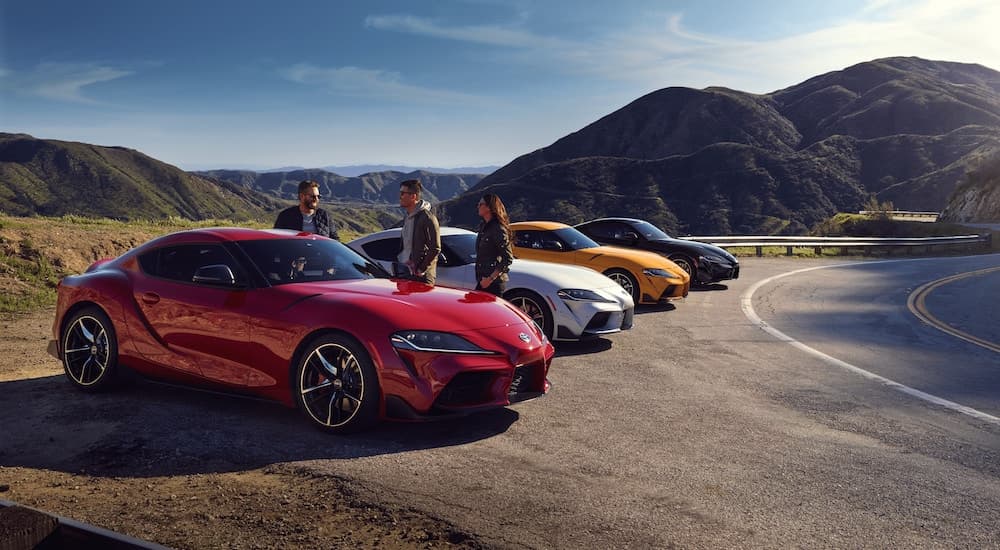Today is a good day to be a fan of Japan’s largest auto manufacturer. It wasn’t so long ago that (outside of some off-road rigs) the Toyota name was synonymous with reliable but boring appliances that no driving enthusiast would want to be caught dead in. However, Toyota has changed course almost overnight, and there is now a plethora of fun new enthusiasts-oriented models to choose from. Some may be a little more style than substance (looking at you Avalon TRD), but Toyota also has a pair of fresh new four-cylinder sports cars to choose from – the 2021 Toyota GR Supra 2.0 and the 2022 Toyota GR 86.
In a world where traditional FR performance cars are nearly impossible to find, to have two different options from the same brand is incredible. We can only applaud Toyota for keeping this shrinking segment alive (even if they did have to partner with Subaru and BWM to share the costs of developing these low-volume dedicated performance models). However, while these two new cars are both four-cylinder coupes sharing their names with legendary Toyota models, they have taken different approaches to their legacies and have met with different reactions from the car community.
A Reputation to Live Up To
While Toyota fell into a bit of a slump at the dawn of the new millennium, focusing on developing what was arguably the antithesis of the enthusiast’s car, any JDM fan (or Fast and Furious aficionado) will be more than happy to regale you with Toyota’s glorious performance history. Before the Prius era, Toyota was a major player in the development of sports cars of all stripes, from the affordable mid-engine MR2 to the Celica GT-Four WRC homologation special. However, two nameplates cast a shadow over the rest.
Here in America, the Supra A80 (MkIV to most American fans) with its turbocharged 2JZ became a dragstrip legend that rocketed to widespread popularity after its appearance in The Fast and the Furious. On the other side of the Pacific ocean, a slightly older model found widespread acclaim in Japan’s early drift culture, cementing its global fame with its central role in the Initial D anime, manga, and video games. Sold under a variety of names, including “Corolla Levin,” “Sprinter Trueno,” and “Corolla Sport GT-S,” most enthusiasts refer to this car by its AE86 model code.
When Toyota decided to restart its performance line, it is no surprise that the brand decided to turn to these two iconic nameplates and bring them into the modern era with the GT86 and the GR Supra. However, that is where the controversy began. Legendary cars are surrounded by strong emotions, and even the best modern take on a classic usually comes under fire from everyone who loved the original.

GT86 vs AE86
Surprisingly, the GT86 didn’t see all that much backlash here in America. Outside of anime fans, the AE86 was not a culture icon to the American driver, and the fact that this model was originally marketed as the Scion FR-S likely further deflected many comparisons to the iconic original. The GT86 also didn’t look all that much like the AE86, with sleek and flowing modern lines replacing the boxy shape and trademark pop-up headlights of the ‘80s car.
In fact, it is rather difficult to make the argument that the GT86 bore anything more than a spiritual connection with the AE86. They were both lightweight two-door FR models with a four-cylinder engine, but that was about where the comparison ended. The AE86 was a modified Corolla with a high-revving 1.6L Toyota inline-four, while the GT86 was a dedicated sports car with a 2.0L Boxer engine borrowed from Subaru. Yet despite these departures from the AE86, the modern car has more defenders than detractors when it comes to its legacy. In fact, the main complaint has been that Toyota didn’t go far enough in adding power and features.
With the second-generation GR 86, Toyota listened to those complaints and moved its affordable FR further from its claimed AE86 heritage. Embracing its sports car side, the redesigned 2022 model boasts an even larger 2.4L Boxer engine (which rumors claim will be shared with the redesigned 2022 Subaru WRX) and is tricked out with premium goodies like a standard digital instrument cluster, enveloping bucket seats, and even adaptive headlights that swivel with the steering wheel to cast light down tight corners.
A90 vs A80
In contrast, Toyota took the opposite approach with the GR Supra. Rather than focusing on building the spiritual successor to the A80, a car that had fought on even ground with the best Europe could build, Toyota chose to focus on repackaging the major features of the A80 in a modern car. With rounded lines and a ‘90s-style rear hatch, the A90 Supra is just a missing wing and a few too many fake vents off the looks of the A80. Toyota even went out of its way to source a new 3.0L turbocharged inline-six from BMW rather than substitute one of its own V6 designs.
While the performance of the A90 is certainly improved over that of the A80 (don’t let the heavily modded ‘90s Supras fool you – the 1997 car was down over 60 horses compared to the 2022 model and over a second slower on the quarter-mile), it lags behind the top dogs of the modern era. In fact, the new C8 Corvette is a second faster both from 0 to 60 and on the quarter-mile than the A90 Supra. Back in the ‘90s, the A80 held the edge over the C4 in pretty much every metric.
This mellowing of the Supra for its latest generation is definitely reasonable grounds for some of the criticism of the new car. Its BMW heritage is another obvious sticking point for Toyota fans, though Toyota’s partnership with the legendary Bavarian manufacturer is more likely to have improved the A90 than handicapped it. But perhaps the greatest criticism is the least deserved – the introduction of the 2021 Supra 2.0 with its inline-four engine.
While the mighty twin-turbo 2JZ gets all the press, it should be remembered that it was always sold alongside a naturally aspirated version pumping out just over 220 hp and 210 lb-ft. Compared to those less than awe-inspiring numbers, the 255 hp and 295 lb-ft of the 2.0 is a more than competent engine. In fact, A80 fans might be disappointed to learn that the 2.0 is almost a half-second faster to 60 than their ‘90s icon.
Japanese Sports Cars Are Still a Thing
With the 2022 GR 86 and the 2021 Supra 2.0, Toyota has designed two modern sports cars that built on their legendary names in rather different ways. While both are solid designs that fill their respective niches well, the different approaches to accommodating their legacies created different impressions in car culture.
The GT86 captured the spirit of the original drift car, instilling it into a vehicle that bore little resemblance to the storied AE86 when it came to aesthetics or mechanics. While it looked and sounded different, the GT86 remained affordable and lightweight, creating a small but dedicated fanbase. With the redesigned 2022 GR 86, Toyota listened to the valid criticisms of the GT86, building a car that was more powerful while continuing to remain spiritually true to the AE86.
The A90 Supra bore a striking visual and mechanical resemblance to the A80 Supra, albeit with 30 years worth of styling cues and a decidedly Germanic touch. However, it largely failed to capture the original’s spirit of being a world-class sports car, maturing into more of a luxurious but competent touring car rather than a dragstrip monster. With the introduction of the 2021 Supra 2.0, the A90 strayed further from its mythical status, even though the Supra had included a less powerful version in every previous generation.
Both of these cars are just entering the market today and have yet to move out from under the shadows of their predecessors to build reputations of their own. While it seems likely that the 2022 GR 86 will prove to be a success, improving on the few criticisms of the original GT86, it remains to be seen if the car community will warm to the newest member of the Supra family. However, no matter your opinion on these two new cars, we should applaud Toyota for being willing to keep the traditional FR coupe alive for a few more years.





